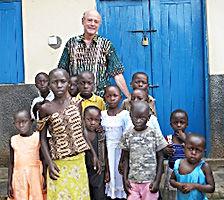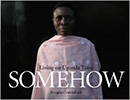Peace Corps Writers 2014 Award For Best Book of Photography

The Award for Best Book of Photography was first presented in 2009.
•
CONGRATULATIONS to Douglas Cruickshank (Uganda 2009–12) for winning the Peace Corps Writers 2014 Best Book of Photography for his photography and his essays for Somehow published in 2013. Douglas will receive a small cash award and a certificate.
Douglas Cruickshank has written journalism, travel stories, profiles, essays and opinion pieces for many magazines, newspapers and web sites and has worked in radio, television and film-making. He has been a photographer for more than four decades, a columnist and editor for Salon.com, and has edited numerous books.
The following account, drawn from the introduction to Somehow: Living on Uganda Time, tells of how he came to join the Peace Corps, and his first impressions of Uganda.

Photo of Douglas Cruickshank with Ugandan children by Judith Calson
In early 2008 I started doing something. At first, I didn’t know exactly what I was doing or why I was doing it. But as the months of that year led from one to the next, both the what and the why began slowly coming into view.
What I was doing was getting rid of everything I owned. The reason was that I no longer wanted so many things to look after; it had become clear to me that it was time to move on — in every way possible.
A year and a few months after the Great Shedding of Things began, I decided to join the Peace Corps — at age 56. I don’t recall where the idea came from, but once it popped into my head it seemed the right thing to do at the right time, and I became very focused on it. Eight months later, in early August 2009, I boarded a plane that took me to Uganda, a place I knew almost nothing about; I had never been there nor anywhere else in Africa.
After arriving in Uganda, I spent several weeks living near Kampala with a family of 13, terrific folks whom I really enjoyed. Then I moved 6–7 hours’ drive across the country to the Rwenzori Mountains village of Kyarumba, located in the far west, about 20 miles from Uganda’s border with the Democratic Republic of Congo (DRC). It was there that I lived and worked for the next two-and-a-half years.
•
Review of Somehow
first published in Peace Corps Writers on January 3, 2014
Somehow: Living on Uganda Time
(Essays and photographs)
by Douglas Cruickshank (Uganda 2009-12)
Verflectin Media
$60.00
420 pages
2013
Reviewed by Don Messerschmidt (Nepal 1963-65)
Douglas Cruickshank’s Somehow: Living on Uganda Time, is a big book, and its 400 pages of photos and text are heavy, amazingly so. Not as in “heavy going,” but as in profoundly engrossing. To both the author/photographer and his friends the Ugandans, it is heavy with special meanings; stimulating, fascinating, captivating and . . .. You get the idea.
When he joined the Peace Corps and went to Uganda Douglas Cruickshank was 56 and had recently downsized his life. He called it the “Great Shedding of Things,” having sold and given away most of his possessions and encumbrances — except his camera, a sense of adventure and his way of seeing and capturing the essence of life digitally. He entered Uganda as a stranger in a strange land, but not for long. His camera helped make it familiar and meaningful.
Think of Uganda and what comes to mind? — Idi Amin, gorillas, ebola and more, all packaged in a space slightly smaller than the state of Oregon, populated by 35 million people (vs. 4 million in Oregon) speaking at least 50 different language and dialects. But Cruickshank’s Uganda is much more than all of that, a kaleidoscope of unique places and events, ordinary people, and animals.
 His first impression upon arriving at Uganda’s Entebbe airport was all the people: “They were everywhere. Many of them. Doing many things . . . [on] the roadsides, walking home or away from home . . . in huts, in shops, on bicycles, on motorcycle, leaning against trees, in bars and cafes; people around fires, working on cars, laughing, arguing, sweeping and washing, cooking and eating.” People who, when he got settled and they began to know him, “were always happy to see me and inevitably asked me to join them.” And, soon, he was photographing them and their unique place on earth. Both he and they were happy — it shows.
His first impression upon arriving at Uganda’s Entebbe airport was all the people: “They were everywhere. Many of them. Doing many things . . . [on] the roadsides, walking home or away from home . . . in huts, in shops, on bicycles, on motorcycle, leaning against trees, in bars and cafes; people around fires, working on cars, laughing, arguing, sweeping and washing, cooking and eating.” People who, when he got settled and they began to know him, “were always happy to see me and inevitably asked me to join them.” And, soon, he was photographing them and their unique place on earth. Both he and they were happy — it shows.
Douglas was posted to a coffee-growing region in the west of Uganda (next to the Democratic Republic of Congo). It’s where he lived and worked, made lifelong friends, and photographed them over several years.
He’s a superb photographer and an equally evocative writer, with well defined wit and wisdom. I like the way he explains his confrontation with the local language, for example, a language that he never fully mastered. Even the locals told him it was tough to learn.
“The clan in that mountain region,” he writes, “is the Bukonzo, which is sometimes spelled Bakonzo or Bakonjuo. The plural is Mukonzo or Mukonjo . . .. The language is Lhukonzo. . .,” in a land where “the local languages change every 50–60 miles . . .. Other names for the language include Konjo, Rukonjo, Olukonjo or Olukonzo.” He concludes that “it didn’t really matter how I pronounced a word, someone would correct me. It never failed.”
The books digital imagery makes up the bulk of the book, punctuated by short, insightful and often poetically philosophical essays.
In a Foreword entitled “A Sixth Sense,” his friend and fellow photographer, Owen Edwards, describes the importance of Douglas Cruickshank “being there,” capturing a sense of place for his readers’ and viewers’ delight. “For a photographer,” Edwards writes, “the best sort of ‘being there’ is being there — wherever — for long enough to blend in, to witness the everydayness of the locals and, as E.M. Forster urged, ‘only connect.’” Cruickshank was there, and he connected.
“Seeing — entirely and intensely — the where and the when and who of a place is the alchemist’s ability needed for the best photography of new worlds.” To Edwards, Cruickshank has a double ability — “to connect emotionally, then to collect visually.” To that I’ll add a third: the ability to project what he’s captured artistically and with spirit. These are some of the keys to the book’s success.
Somehow is a collection of 80 themes, some illustrated by one photo, some by many. There is also Cruickshank’s Preface, Edwards’ Foreword, an Afterward, and Acknowledgments. The Afterward is really an AfterWord — a short, sensitive look back at Africa through one American’s eyes, and at America by one whose viewpoint has been molded by the African experience. In the end, he’s “resigned to the fact that the two can’t really be reconciled” — though I think his photos come very close to it.
The themes include some startling titles. Here are a few:
Omwanjakyanjakya — it means “morning,” but we stumble to pronounce it correctly even after he tells us how.
Pterodactyls to Watch Over Us — illustrated by a photo of marabou storks in the rain, which looks like a modernist painting.
“What that Sound, Elijah” — about a 4-month-old child who is captivated by Cruickshank’s whistling. With a charming photo.
True Fabrications — a collage of colorful African fabrics.
A Permit to Visit the Relatives — an essay on the bureaucratic banter (and bank notes) necessary to enter a mountain gorilla preserve, to photograph our distant relatives eating leaves.
Erection — a take-off on a 1971 John Lennon film (with that embarrassing title) featuring the building of a London hotel. Cruickshank’s version depicts the progressive construction of Ugandan houses and small buildings, without modern tools.
Some Kind of Son — a portrait and essay of a boy named Ronaldo who has pasted a picture of a soccer star, his hero, on his forehead. This particular photo even excited Owen Edwards.
And so on, each as engrossing as every other, accompanied by short essays that help set the scene and the feeling of “being there.”
I’ve viewed and read enough fine coffee table books to I rank this one among the very best. My take away after viewing Uganda through Cruickshank’s lens is the distinct feeling now that I’ve been there, too.
You can reach Douglas Cruickshank at: http://douglascruickshank.com/
•
Reviewer Dr. Don Messerschmidt is an anthropologist, writer, and an international development consultant. He was born in Alaska, and graduated from the University of Alaska in 1963. Shortly thereafter he first went to Nepal as a Peace Corps Volunteer working in rural development. He then stayed on in Nepal, where he lived off and on for many of the last 50 years as a teacher, rural development consultant, researcher and writer.
.
No comments yet.
Add your comment